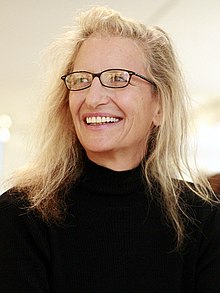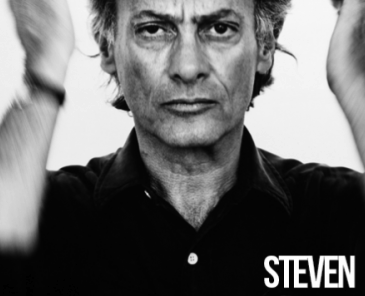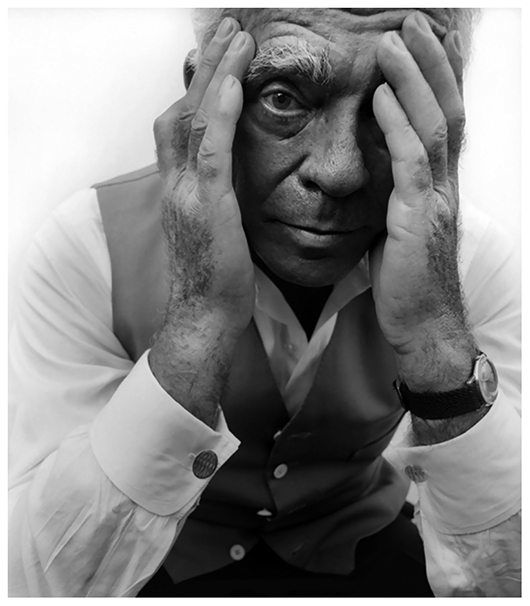Anna Lou «Annie» Leibovitz (Waterbury, Connecticut, October 2, 1949) is an American photographer. She was the first woman to exhibit her work at the National Portrait Gallery in Washington D.C. and the last to portray musician John Lennon, before he was assassinated in 1980.
She is the highest-paid photographer in the world and has worked for magazines such as Vanity Fair, Rolling Stone, and Vogue. In 1984 she was awarded by the American Association of Magazine Publishers as Photographer of the year. In 1988 he received the Clio award for the American Express advertising campaign. In April 2000, the United States Library of Congress gave her the title of "Living Legend". In 2005, American Photo magazine named her the most influential photographer of our time. In May 2013, she was awarded the Prize Prince of Asturias of Communication and Humanities.
Although she is known primarily for her celebrity portraiture, she has practiced documentary and landscape photography, contracted to Condé Nast Publications since 1993. Her images have been represented since 1977 , by Contact Press Images photojournalism agency.
She is the third daughter of the Jewish couple Samuel Leibovitz, a lieutenant colonel in the Armed Forces, and Marilyn Heit, a contemporary dance instructor. Her father's military work they forced Annie and her five siblings to move frequently.
In high school Leibovitz became interested in various artistic fields. She began writing and playing music, and entered the San Francisco Art Institute in 1967 because she wanted to be an art teacher. Her interest in photography arose in a dark room at Clark Air Force Base in the Philippines, where her father he was stationed during the Vietnam War. For several years he continued to develop his photographic skills while working in different locations, including a stint on an Israeli kibbutz in 1969, where he participated in an archaeological dig at King Solomon's Temple.
Returning to the United States in 1971, Leibovitz earned a Bachelor of Fine Arts from the San Francisco Art Institute, later working with photographer Ralph Gibson.
During this period she applied to work as a freelance photographer at the then-emerging Rolling Stone magazine. The editor, Jann Wenner, was impressed with her portfolio and allowed her to join his publication's staff. Two years later, Leibovitz was promoted to chief photographer, a position she held for ten years and shot one hundred and forty-two. covers.
In 1975 he was commissioned to document the Rolling Stones Tour of the Americas '75 musical tour, which the British group The Rolling Stones performed in the United States and Canada. Years later, Rolling Stone's headquarters moved to New York, so Leibovitz left the city of San Francisco after living there for ten years. His arrival in New York was accompanied by various problems, including his addiction to drugs, especially cocaine.
On December 8, 1980, Annie went to musician John Lennon's apartment to photograph him for Rolling Stone. She promised him that one of these images would illustrate the cover of the magazine, although the editors did not want his wife, Yōko Ono, to be pictured alongside him. Annie's idea was to recreate the image from the Double fantasy album cover from the Lennon himself. Hours after the photo shoot, John was killed by his admirer, Mark David Chapman, who shot him four times outside his building in New York. Finally, the photograph that Rolling Stone published on January 22, 1981 on the cover - without headlines - was the one in which Lennon appears naked and curled up next to his wife fully dressed as him.
Since 1983, Leibovitz has worked as a portrait artist for the American magazine Vanity Fair, receiving up to 2 million dollars a year for it.
In 1993 she sued the film company Paramount Pictures for infringing the copyright on a photograph of hers. The image, which graced the cover of Vanity Fair two years earlier, was that of actress Demi Moore nude showing her pregnancy, a parody of which Paramount had made to promote their comedy film Naked Gun 33⅓: The Final Insult. The poster showed actor Leslie Nielsen "pregnant" and posing exactly like Demi. Annie lost the lawsuit when the court found that the parody photo of her was fair use.
Since 1995, Leibovitz has been on a mission to photograph the actors and actresses who appear in The Hollywood Issue, an edition that Vanity Fair publishes in March each year with portraits of the actors Hollywood highlights.
In May 2006, Vanity Fair published for the first time a special issue dedicated to caring for the environment: The green issue. The photograph that graced the cover of this issue was taken by Leibovitz, who portrayed actors Julia Roberts and George Clooney alongside environmental activists Robert F. Kennedy Jr. and Al Gore. For this image, Annie was inspired by the photograph Ballet society, taken by Irving Penn in 1948. In the following year's edition, it was actor Leonardo DiCaprio who posed for Leibovitz on a glacier in Iceland. She made a photomontage to get the famous polar bear Knut to appear next to DiCaprio sitting on the ice.
The entire cast of the television series The Sopranos reunited for the last time at Leibovitz's photo shoot for Vanity Fair. The report, published in April 2007, was due to the end of the series in June of that year.
In September 2007, Annie was the first to photograph the daughter of actors Tom Cruise and Katie Holmes, Suri, putting an end to rumors that the baby did not exist The image, where the girl peeks out from inside her father's jacket, was published on the cover of Vanity Fair. The rest of the photographs appeared in the twenty-two page report dedicated to the Cruise-Holmes family.
In July 2007, Annie had to photograph twenty-one celebrities (actors, singers, models, businessmen, athletes, politicians, and religious) to grace the twenty different covers that Vanity Fair published in his special The Africa issue, edited by the singer Bono.
At the end of 2007, Leibovitz had exclusive access to the filming studios of the film Indiana Jones and the Kingdom of the Crystal Skull, where she was able to photograph its protagonists and their directors. These became the first images of the film before its release in May 2008 and were published by Vanity Fair in its February issue of that year.
On February 14, 2008, Vanity Fair collected the most notable celebrity portraits of her for the Vanity Fair portraits-photographs 1913-2008 exhibit, which was mounted at the National Gallery of London Portraits. Annie was one of those who participated in the show.
In May of that year, controversy arose when Annie portrayed then-fifteen-year-old singer-actress Miley Cyrus with only a sheet covering her bust. The Disney company, where Cyrus worked, regretted that Vanity Fair deliberately manipulated a fifteen-year-old girl to sell more magazines. Days later, Miley apologized to her fans, arguing that the magazine had led her to believe that the images were intended in an artistic manner. Ultimately, Leibovitz declared through a press release in Vanity Fair that his photograph had been misconstrued.
In 1986 she was invited to make a series of posters for the Soccer World Cup in Mexico. This was the first time in the history of the tournament that a photographer was entrusted with such a mission.
In 1988 she photographed various celebrities for an advertising campaign for the American Express credit card, for which she won the Clio Award. Two years later she founded the Annie Leibovitz Studio in New York.
In 1991, she became the second living photographer—and the first woman—to exhibit her work at the National Portrait Gallery in Washington, D.C. The show, which featured more than two hundred black and white and color portraits, was followed by the publication of the book Photographs: Annie Leibovitz 1970-1990. That same year, Leibovitz wanted to emulate the feat of photographer Margaret Bourke-White by mounting one of the gargoyles on the sixty-first floor of the Chrysler Building —in Manhattan— to photograph the dancer David Parsons. Life magazine photojournalist John Loengard photographed her near danger atop the statue. Also in 1991, dancer Mikhail Barishnikov invited Annie to document the creation of his White Oak dance project.
In 1992 the short film Zoetrope, directed by Leibovitz, was shown in the United States through the Public Broadcasting Service television channel. In 1993 he began working for the fashion magazine Vogue and received an honorary doctorate from the San Francisco Art Institute, where she had studied in her youth. At that time, the San Francisco AIDS Foundation exhibited a series of portraits taken by Annie of people sick with AIDS,35 and an exhibition was also set up with the photos that she had captured during the Siege of Sarajevo and the Bosnian War months before.
In 1996, Leibovitz was the official photographer of the Summer Olympics in Atlanta, Georgia. A compilation of black and white portraits of athletes was published in June of that year in the book Olympic portraits. Her next publication was Women (1999), which was accompanied by an essay written by her partner, Susan Sontag. In the female portraits of this collection appeared judges, miners and farmers, among others.
In the year 2000 she was in charge of choosing and retracting five women for the calendar that the Italian company Pirelli publishes every season.
The New York Times subsequently hired Leibovitz to document the construction of its corporate building in New York City between July 2005 and July 2006. The collection of thirty-five images was inspired by the photographs that Lewis Hine and Margaret Bourke-White took in the 1930s of the Chrysler and Empire State buildings respectively.
In October 2006, the documentary Annie Leibovitz: A Life Through the Lens was shown, directed by Annie's younger sister, Barbara. It showed intimate scenes from the photographer's life, as well as interviews with various celebrities who posed for her.
A retrospective of her work was held at the Brooklyn Museum, from October 2006 to January 2007. The exhibit was based on her book Annie Leibovitz: a photographer's life , 1990–2005 and included portraits of celebrities as well as his own family. Among the photographs was the body of Susan Sontag, who had died of cancer in 2004.
In 2007, Queen Elizabeth II of the United Kingdom asked Annie to take the official photos of her state visit to Virginia. The photographic session was recorded by the BBC television channel for the documentary A year with the Queen (in Spanish: 'A year with the Queen'). A promotional trailer for the documentary showed the Queen reacting angrily when Leibovitz suggested she remove her crown to look more casual. Another scene was then shown showing the Queen walking down a corridor while telling an aide, "I'm not going to change nothing. I've had enough of dressing like this, thanks to you." The BBC later apologized and admitted that the sequence of events in the trailer was wrong,45 and that the trailer was released in error, because it contained outtakes.
Also in 2007, the Walt Disney Company hired Leibovitz to take a series of photographs featuring celebrities playing different characters from their classic movies. The ad campaign was called Walt Disney world's year of a million dreams (in Spanish: 'The year of the million dreams of the Walt Disney world').
In late July 2007, fashion accessories brand Louis Vuitton ran an ad campaign with Leibovitz as the photographer. The celebrities who participated that occasion were the tennis players André Agassi and Steffi Graf, the actress Catherine Deneuve and the politician Mikhail Gorbachev, who posed in the back seat of a car with the remains of the Berlin Wall in the background. Months later, other Entertainment personalities who posed for Annie included The Rolling Stones guitarist Keith Richards, actor Sean Connery, filmmaker Francis Ford Coppola, Coppola's daughter Sofia, French model Laetitia Casta, and astronauts Buzz Aldrin, Jim Lovell and Sally Ride.
In mid-March 2008, Annie photographed model Gisele Bündchen and basketball player LeBron James for a historic Vogue cover. Days later, a group of Commentators, including Samir Husni, claimed that the image had racist connotations, because James's pose was reminiscent of King Kong, while Bündchen represented the blonde who captivates the gorilla. In December of the same year, Annie was included in the list of "The 10 Most Fascinating People of the Year", compiled annually by prominent journalist Barbara Walters.
In 2009 the Royal Photographic Society awarded her the Centenary Medal, which recognizes her significant contribution to the art of photography. In May 2013 she was awarded the Prince of Asturias Award for Communication and Humanities. In 2015 she was recognized with the Páez Medal for the Arts.
(Fuente Wikipedia)








 English (United Kingdom)
English (United Kingdom)